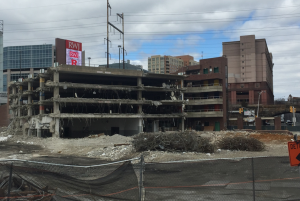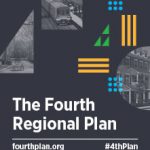New Jersey Future Blog
Forum Roundup: The Future of Parking: Less Parking, Better Management
March 17th, 2017 by David Kutner

The Ferren Parking Deck in New Brunswick during its recent demolition. Photo courtesy of Jim Zullo, Timothy Haahs & Associates.
If you were planning to build a parking structure, would you invest in a 30-year bond to finance it?
That’s the question Bob Goldsmith, partner and co-chairman of redevelopment and land use for Greenbaum, Rowe, Smith & Davis LLP, posed at the beginning of the Redevelopment Forum session entitled The Future of Parking, Today. The session explored whether the decades-long, ever-expanding demand for parking that has influenced the form of urban areas throughout the country will decline as market forces shift and alternative transportation options proliferate.
John Sullivan (presentation), a place-making activist and board member of Bike & Walk Montclair, suggested that declining parking demand presents an opportunity for communities to reclaim a portion of the public realm. He described changes currently being considered to Montclair’s ordinances that will repurpose areas previously devoted to parking into ever-changing public spaces. He suggested that if towns plan for cars, they get traffic and cars. But if a town plans for places and people, it will get enlivened, inviting public places.
Jim Zullo (presentation), lead for transit-oriented development and municipal parking at Timothy Haahs & Associates, argued that structured parking is a key to increasing development density in urban centers. Surface parking has long been overly consumptive of valuable downtown real estate, he said. He also urged municipal officials to consider on-street parking as an asset that, when effectively managed, can reduce congestion and yield financial returns commensurate to its value.
He cautioned that it was essential to “right-size” parking facilities and emphasized the need to share parking to the greatest extent feasible. He suggested that municipalities need to identify creative partnerships and financing strategies, apply market-rate parking fees, and unbundle parking costs from other costs (for example, separate the cost to rent parking from the cost to rent an apartment). Parking facilities should be constructed with a welcoming environment and take advantage of advancing parking technologies that ensure easy, convenient payment – pay by cell; credit card-enabled meters; parking guidance systems and apps; dynamic rate changing; open parking space sensors; and direct enforcement. Automated parking systems, which presently work much better in Europe than in the United States, will enable more efficient parking management.
Rachel Weinberger (presentation), an internationally recognized expert in sustainable transportation and parking policy, quoted Jane Holtz Kay, author of Asphalt Nation, in noting that the more parking you have, the less “place” you have. According to Dr. Weinberger, currently there are three to four parking spaces for every car in the U.S., and these cars are empty most of the time. Zoning codes typically require two or more times more parking capacity than needed. The over-parking dilemma stems from a failure to coordinate parking: Often surface lots overflow while underground parking goes unused. She also noted that building uses frequently change over time but parking requirements typically remain static, which may impede adaptive reuse. She argued that as municipalities evolve, shared parking that reflects changing land uses and varying demand throughout the day could allow for reducing the supply of parking spaces by over 30 percent. As an example, Dr. Weinberger noted that Princeton Borough used an abundance of unused surface parking lots as a basis to designate an area in need of redevelopment.
Bob Goldsmith (presentation) indicated that services provided through Uber and Lyft will have an increasing downward influence on car ownership and that unbundling parking costs is a powerful tool to reduce parking demand. He pointed out that a demand for parking is actually a demand for access, and that free parking distorts market forces. Parking has a considerable value and municipalities of all sizes should charge to make it available.
In summary, the speakers emphasized that to manage parking properly, municipalities need to right-size and right-price it, update antiquated codes and parking requirements, and inventory parking availability carefully. Finally, municipalities should consider working with employers on parking cash-out programs to reduce demand. Such programs require employers to place a financial value on employee parking and to offer employees a cash allowance of similar value in lieu of a parking space, thereby reducing vehicle commute trips and auto emissions.
Returning to the question that opened this session, the answer seemed to be that municipalities should consider methods to limit long-term investments in new parking facilities and to seek creative options to share and reduce parking demand, because that’s the direction new parking technologies, ride-sharing services, and declining interest in car ownership are all pointing.















